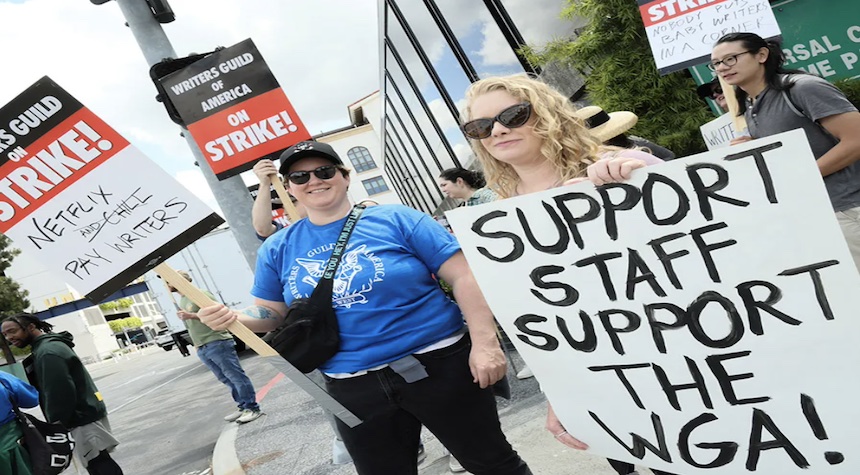The Writers Guild of America praised the studios for the new agreements they had made after a long period of work stoppages and two strikes. The Writers Guild of America was ecstatic about the new deals they had made with studios.
There is a new plot twist in today’s entertainment industry. Writers are now finding that there is less work. Motion pictures are no longer being made at the same rate, TV pilots are fewer, and there are fewer new projects than in previous years. What is going on?
In our most recent episode of The Culture Shift, we talked about a shocking statistic. The amount of production in California has dropped dramatically since the strike ended. The number of shooting days in film and TV productions has fallen by -8.7%. On the television side, this drop is even more dramatic at -16%. It is a stark contrast to the expected increase in work as studios were suspected to have a backlog of productions. What is going on, and why has the number of new projects dropped? Many of the reasons are economic.
First, it is likely that studios were anticipating the strikes and went on a script-buying spree. The studios were trying to avoid not having any new material, but the Actors Guild also had a stoppage of work in the summer. What was the result? Many studios have a large pile of screenplays that are not yet shot. These hold more appeal now, as new scripts can be expensive.
What is happening with television? One thing is that broadcast networks continue their ratings decline. Football is the only thing that people watch with energy. “60 Minutes”, boosted by the NFL, is the most popular non-sports program. Scripted shows are struggling to make the top 150. During the strike, no scripted show made it into the top 200.

This was due to several factors. The rise of streaming platforms caused a massive increase in demand for products. For the sake of the competition, streamers had to create new content and build up their catalogs to provide value to subscribers. This led to an unpleasant reality.
Netflix is the only platform with a lot of capital. The costs to start new content and build up existing content have been high for the competitors. Disney+ and Paramount+ have both suffered annual losses of billions of dollars, while also losing subscribers, at a moment when they were expected to grow and reach break-even. After that, the cost of maintaining libraries was a major drain.
The vault was initially a selling feature, but it soon became a problem. The companies must pay royalties on the content they own. As subscribership declined, what were originally thought to be loss leaders became true liabilities. Paramount had a series that was a good example of this. The “Grease Prequel Series” “The Rise Of The Pink Ladies” was released last spring and it quickly became a mess in the eyes of critics and audiences. Paramount+ canceled the show before its conclusion and announced that it would no longer be available on its library. The company was aware of the low demand for the show and didn’t want to pay royalties for a show with little interest.
Studio and platform owners are less willing to accept any script just to get property. These days, they need a surefire audience. This production hesitation for new programming is due to another, less visible factor. This is hidden in the metrics for shooting days, which shows a strange preference for one genre.
Production of TV dramas with a heavy location component dropped by -5.5%, while production of TV comedies with fewer locations fell by -51.5%. In 2023, there were 66 shooting days for TV pilots.

This seems odd at first, considering that location shooting is more difficult for dramas. This type of show requires a bigger crew and more cameras. The mobility of the crew is also a challenge. So why are there more days for filming when sitcoms only have one static set? One of the provisions in the strike agreement may provide an answer.
The new contract included a component that increased the staffing in writers’ rooms. The studios must also meet the higher minimums of writers to maintain the new rates. It will also lead to fewer episodes and a move towards dramas with action. For example, less writing is required for action sequences that include fight scenes, car chases, and shootouts. Sitcoms with a lot of dialogue and studio dramas need more writing.
Another reason for the contraction of the industry is that the financial forecasts mean tougher decisions are being made. In February, Reuters interviewed industry leaders who weren’t optimistic about the future of the entertainment business. Revenues dropped in 2023, and are expected to drop further this year. Belt tightening was already a concern, and it came at a time when the help demanded a larger cut.
The crew unions have entered the negotiations stage with studios and appear to be bolstered after the two strikes last year. The specter that the unions will walk out by July is a reason enough for productions to proceed with caution. Studio approvals of scripts are no longer given on a whim. The flashing yellow light that once surrounded the industry will soon turn red.
Few writers could have imagined this plot development.


